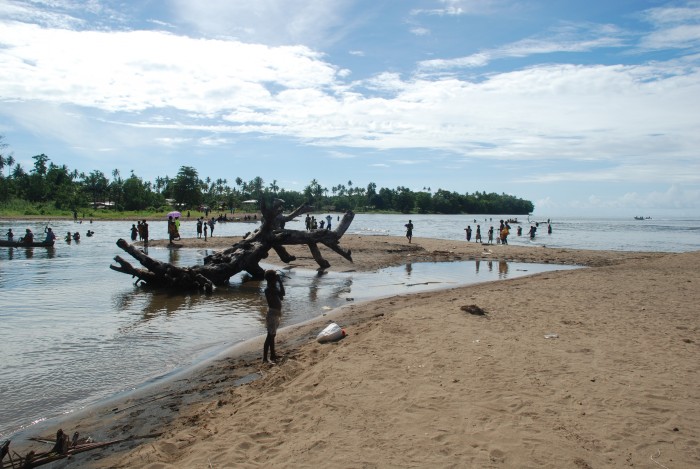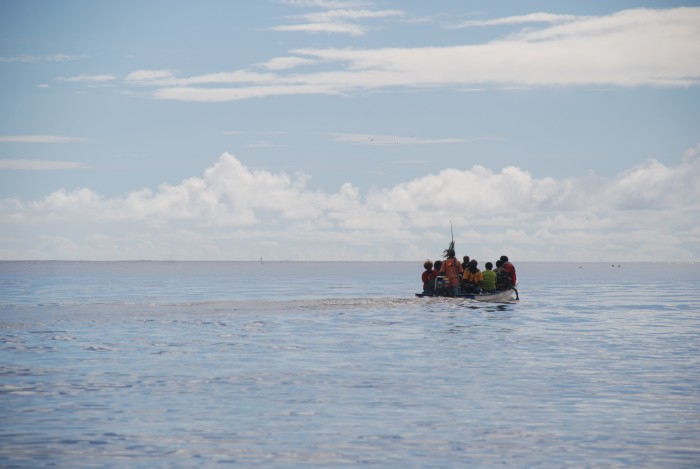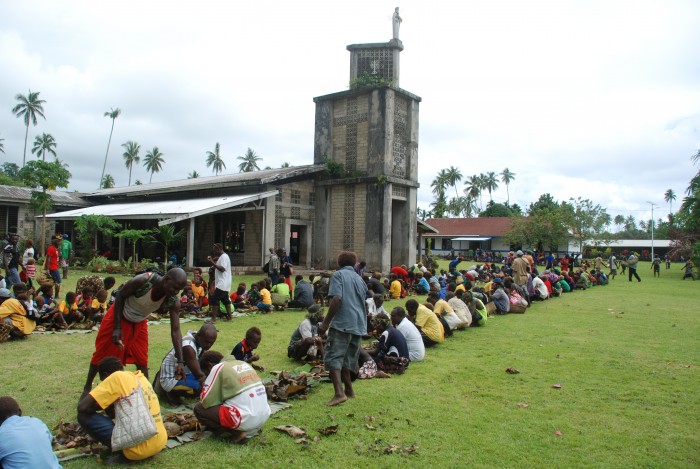Ranguva Solwara Skul, Kaselok Village, New Ireland Province, Papua New Guinea
Participants: Sekunda Aini, Michael Tarere, Ambrose Kolmaris, Hagar Boskuru, Bernard Miller Silakau, Wilson Tonias, GomanMatas
On 13 December 2015, the authors and participants gathered at the headquarters of Ailan Awareness, a locally owned environmental NGO in New Ireland Province, Papua New Guinea, to talk about climate change. Eight of the nine of us reside in Lovongai Village in the nearby island of New Hanover. The majority of our conversation was focused on changes that were occurring in that particular village, with useful comparisons being made to “mainland” New Ireland. This was, in part, a local response to the United Nations Climate Change Conference (COP21) held in Paris earlier in the month.
Lovongai Village is situated on the banks of a winding river that flows from the mountains of New Hanover, bisecting subsistence gardens and homes on its path to the sea. At the river’s mouth is a shallow harbor, which is bordered on both sides by fringing coral reefs. These reefs host many kinds of small fish and sedentary resources, and larger pelagic species cruise the waters just offshore. For many generations, the forest, the river, the harbor, the reefs, and the deep sea have provided life, mobility, and security for the people of Lovongai. But a walk through the village today reveals something quite different.
Scattered along the shoreline are broken timbers and stumps of coconut trees that once marked the intersection of sea and land.

During the monsoon season (“Matvung” in the Tungak language1, when the wind blows from the west or north, the shallow reefs protect the village and its fragile river from the waves of the Bismarck Sea. But when these waves come directly from the ocean, as they do through most of the year, the reef and the shoreline yield to rising waters. “That was where my house was,” says one of us. “And that is where my brother’s house was, and the houses of two more families. They are gone now.” The heavy sand beneath the posts that supported the homes “was washed away with the ‘king tide,’2 and then the houses fell in.” Nine years after that violent event, the rubble of the homes remain submerged, and those families have moved further inland. But while that unusually high tide stands out as a singular event, it is considered part of a longer process of erosion: “The shoreline has been washed away since I was born. King tide may have done some distinct impacts, but the shore continues to be washed away to this date and faster than ever before.”
In Papua New Guinea, where customary land tenure is often rooted in historical narrative and maintained through ongoing social relations with the living and the dead, a relocation of one’s home to the land belonging to another clan is no easy matter: “With the tide came problems. One of the men who moved inland cleared a space for his family and built a house. He cut down some coconut trees, but those belonged to someone else. Now the parties are disputing in court.”

There are other effects too. “The seasons are different now. We don’t know when to expect them anymore.” “It has become difficult to predict when the rain will come, when the hot sun will come, and when we should spend more time planting crops or fishing.” With changing winds and seasons, “there is more seawater coming up into the river and to the gardens, which is not good for the kaukau (Pacific sweet potato) especially, but also the taro, pumpkin, and greens.”
“The harvest is going down, and we are needing to buy more rice and tinned fish from the foreign-owned shops. But that costs money. Getting to the stores in Kavieng costs us 80 kina just for the boat fare. We will do work and find a way to grow crops. But we need a local buyer. We cannot afford to pay the money for fuel and boat fees to keep traveling to town.”
What has made these trips possible has been the sales of betel nut and daka,3 both of which have continued to grow well in Lovongai, but not in mainland New Ireland because of current El Nino–related drought. In 2015, the people of Lovongai seized the opportunity to cultivate more of these products, selling them in town at a very high price. Yet the higher sales are only a short-term benefit in what is a long-term problem.

Who is responsible for climate change? “It is not only big developed countries that are doing it. It is us, too. When we cut down kwila and other big trees that grow along the beach like we did in the village, the sand erodes away. And now we have these illegal logging companies taking down our trees.4 The rain comes and without trees, we get big landslides and floods that wash over the gardens. The landslides that end up in our river systems finally end up on our coral reefs, suffocate the coral reefs, and make it difficult for marine life to thrive to continue to support our daily protein needs. We also use the sea as a source of salt, recreation, and bathing.”
As this was said, one of us drew an “S” shape in the sand to indicate the normal path of the river and then put a straight line through it to indicate what happens when it floods. “The river gets dirty, and the mud flows out into the reef, where it stays there for sometimes a month. It makes it very difficult for us to find fish.”
Changes in the forest are being compounded by changes on the reef. “Before, some of us in the village were using that derris root5 to catch fish. But fortunately, Ailan Awareness told us it kills those small animals in the sea that build up the reef and other forms of life both on the coral reef ecosystems and the sea,6 and the sea will come in even more. So we stopped doing that. Those animals have a hard enough time with the landslides.”
As some people from Lovongai often reside with friends and family in New Ireland, they have been able to compare the effects on these two places. In the village of Kaselok, which directly faces the northeast (and thus receives the same swells that pass by Hawaii’s fabled north shore), several measures have been taken to protect the coast. In 2013, workshops sponsored by Ailan Awareness and international conservation organizations were held to encourage villages to plant mangrove trees to act as a natural barrier. This planting was attempted in Kaselok village, but unsuccessfully. The mangrove, which has been praised as the solution to climate change by the big international conservation organizations, cannot thrive everywhere. “With each high tide, the young mangroves planted in Kaselok were ripped out by waves that came over the reef. And then there was not enough freshwater flowing into this area to balance the salinity of the sea.” Now, those living on this exposed shoreline have been placing leaf litter and other organic matter along the beach and growing kwila and other beach trees to “form a kind of seawall” to hold off the incoming tide.
None of us are quite sure how those responsible for enacting climate change policies envision its effects: “When they think of the water rising around an island in the Pacific, are they thinking of calm turquoise water slowly rising onto white sandy beaches? If so, they would be wrong.” During our discussions, it became clear that climate change in New Ireland and New Hanover involves a network of causes and effects at multiple spatial and temporal scales. Its effects are neither entirely good nor bad but present different degrees of threat based on geographic location and social, economic, and political context. It is not only a gradual change occurring to singular variables but better represented as the development of increased variability and more dissonant rhythms.
When asked what could be done to help the situation in Lovongai right now, participants suggested continued education and awareness programs. Specifically, “that all current and future funding from international donors that has been purposed for climate change awareness and mitigation be tied right down to community based projects” and that “all work in this respect be undertaken directly with communities and community-based organizations.”
“What we need is a viable and sustainable market for the marine and terrestrial products we are able to cultivate in spite of the variable conditions. We in Lovongai are hard-working people. We are self-sufficient. But we need support. Our people need to move inland, though there will be serious land issues to deal with compounded by the logging and SABL (Special Agricultural and Business Leases) challenges we are faced with already. With 75 percent of our island under the SABL arrangement (land grab) and 25 percent under a mining lease arrangement, we (over 30,000 people) practically have no land.”
“What we do NOT need is more big international NGOs (BINGOs) coming and going, picking our brains for local knowledge. They come here for one or two days, we take them to our management sites, they promise us this and that, and then they disappear never to return. Or if they do return it is with another project, or to set up new and expensive offices for climate change that have little impact on people living here. We are fed up with them. The support we need has got to be long term and locally driven, and must combine customary conservation practices with useful and intelligible insight from scientific research.”

For more information on the work being done by Ailan Awareness, please visit Ailan Awareness online. The authors and participants of this workshop encourage questions and comments from readers.
Patrick Nason (Columbia University) would like to thank Columbia University’s Graduate School of Arts and Sciences; the Wenner-Gren Foundation for Anthropological Research and the Explorer’s Club for financial support of this research; and the National Research Institute of Papua New Guinea, the Provincial Government of New Ireland and Local Level Government of New Hanover, and especially Ailan Awareness and the participants of this discussion for logistical support.
John Aini (Ailan Awareness) would like to thank Paige West and Catherine Sparks for continued support, advice, and fundraising for Ailan Awareness conservation and management programs, as well as Columbia University’s Graduate School of Arts and Sciences for the ongoing student attachment programs to Ailan Awareness. Financial and logistical support has been made available by continuous support from the Christensen Fund. He also would want to thank the Kavieng District Development Authority and the people of Lovongai, New Hanover, for supporting this research.
Notes
1. Tungak is the language of the Lovongai people—one of more than thirty distinct languages spoken in New Ireland Province.
2. An abnormally high and sudden tide that affected the western Pacific in 2007, including many of the Papua New Guinea islands.
3. Tok Pisin for a mustard seed that accompanies betel nut. The current price in Kavieng is 1 kina (roughly 30 cents) for one daka, considered exorbitantly high.
4. Many areas of New Hanover are being logged by foreign companies, operating under Special Agricultural Business Leases (SABLs).
5. A plant root that indiscriminately kills aquatic life.
6. Referring to coral polyps.
Cite as: Nason, Patrick, and John Aini. 2016. “A Conversation on Climate Change in the Papua New Guinea Islands.” EnviroSociety. 24 February. www.envirosociety.org/2016/02/a-conversation-on-climate-change-in-the-papua-new-guinea-islands.

Reader Comments
Comments are closed.